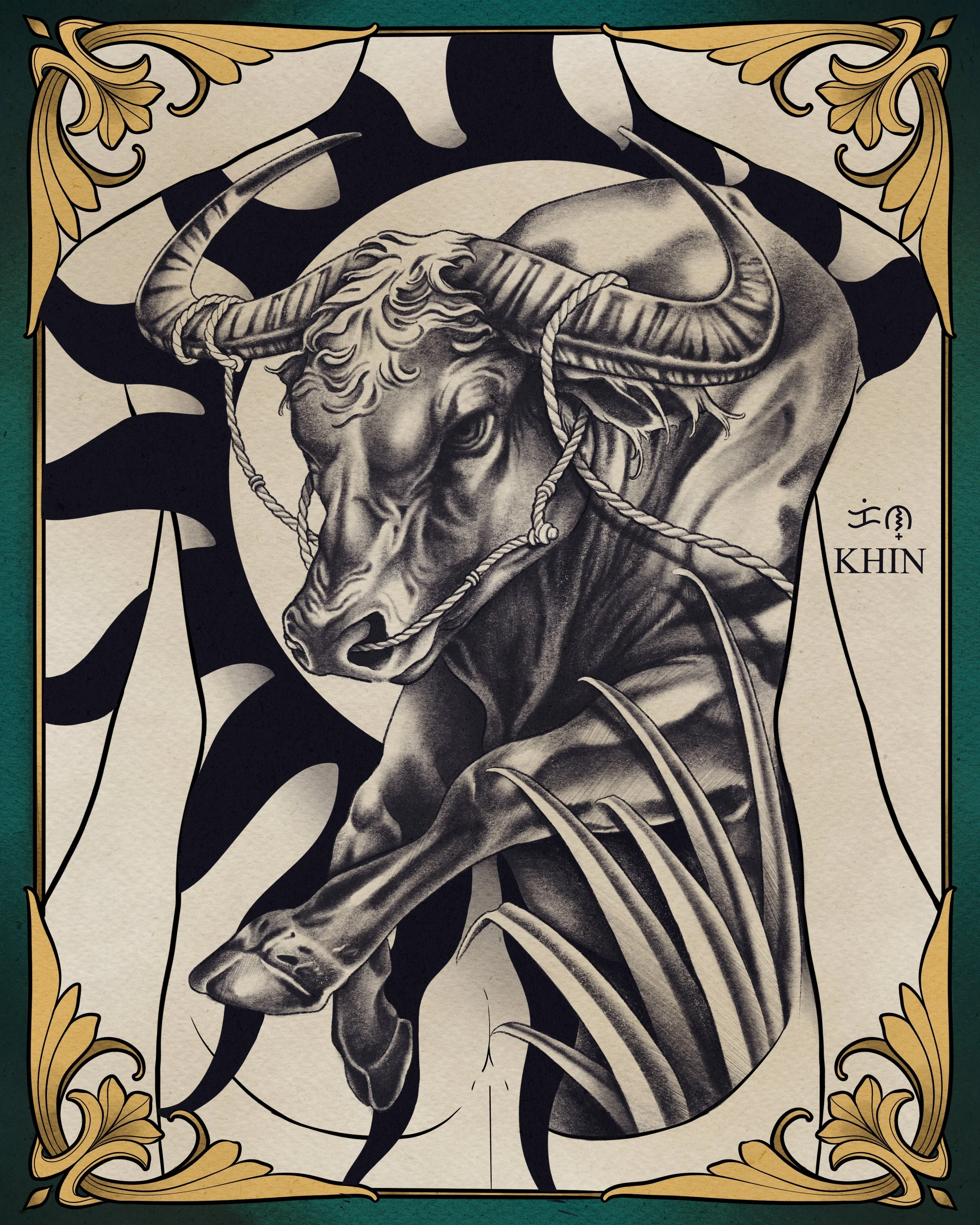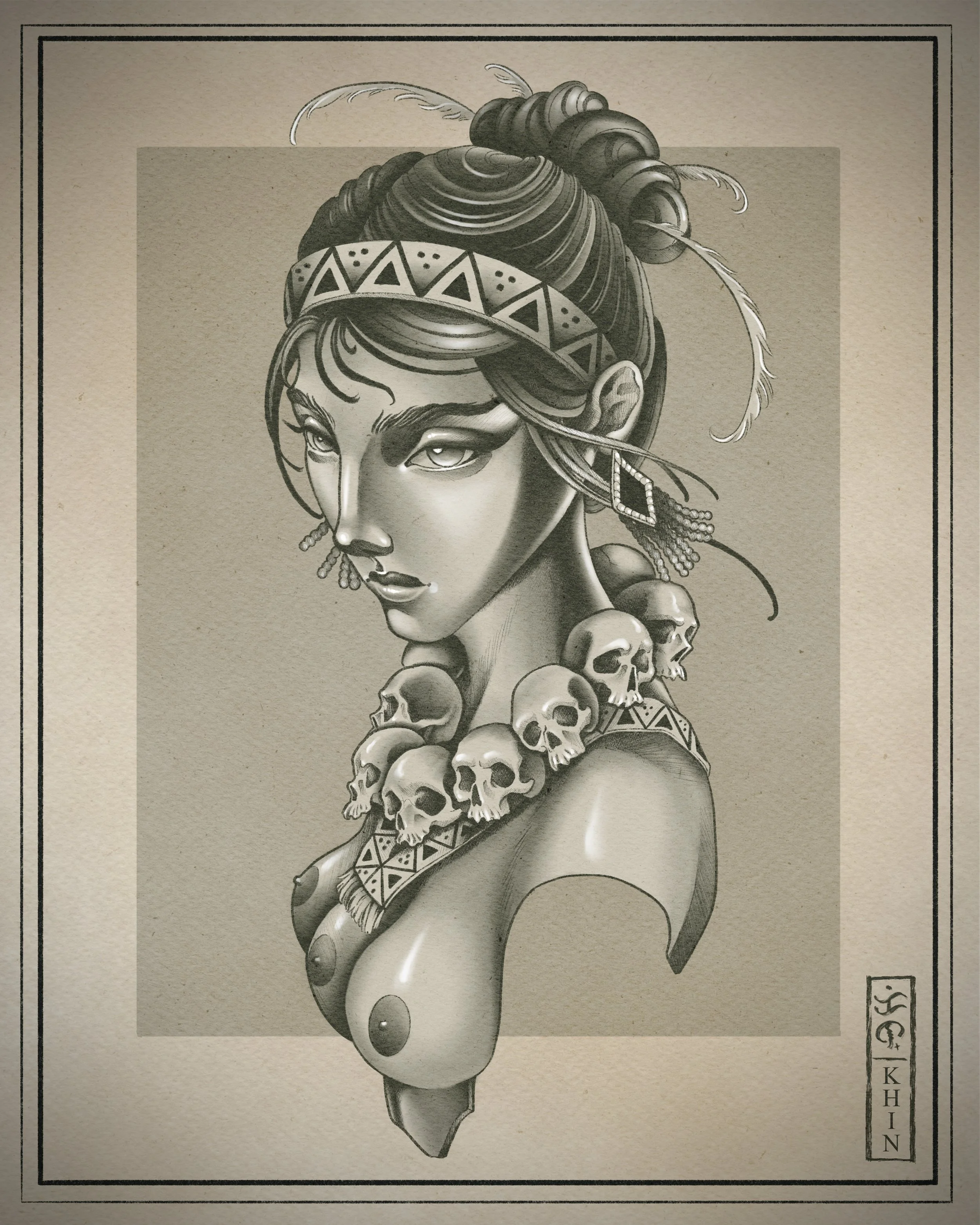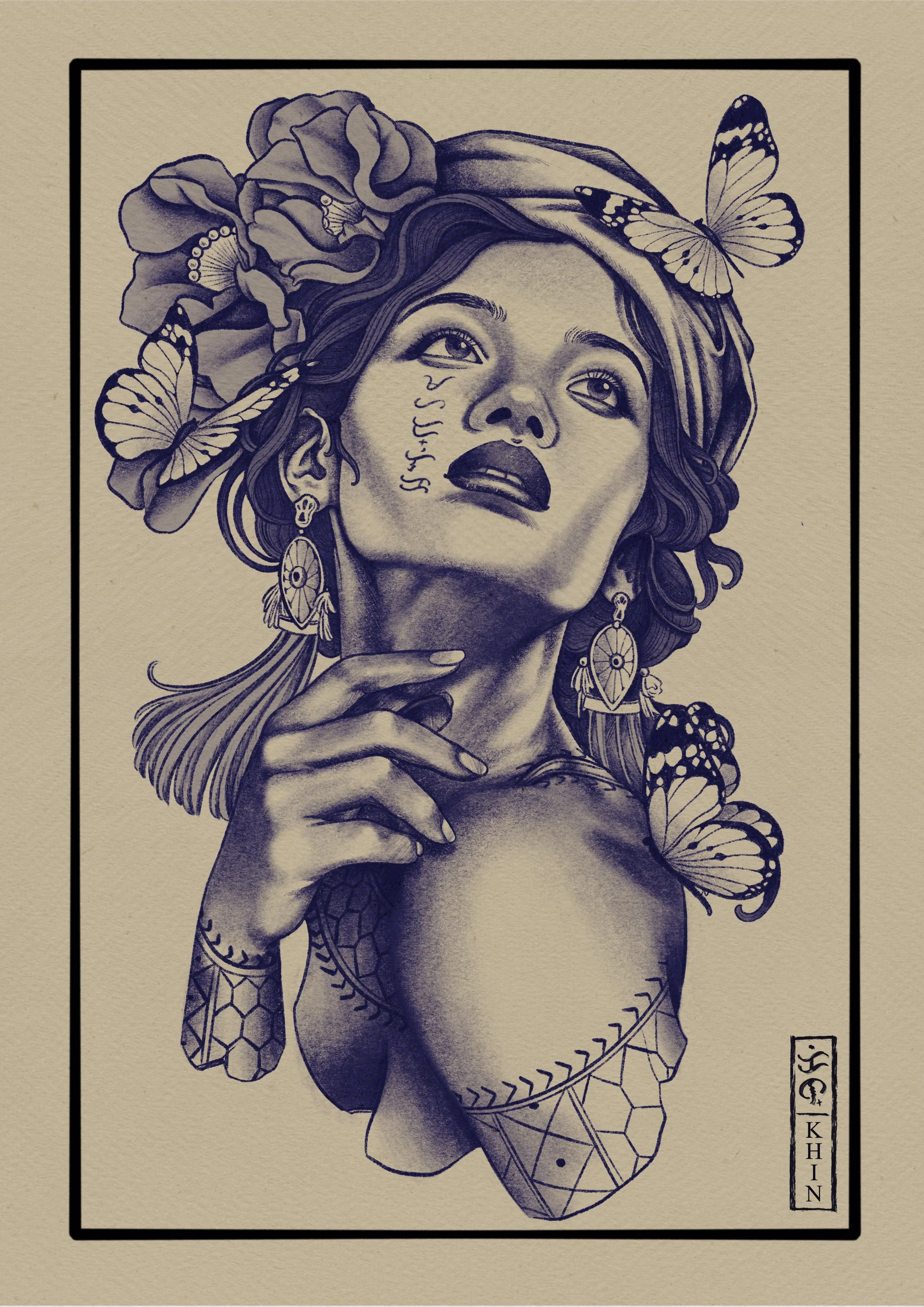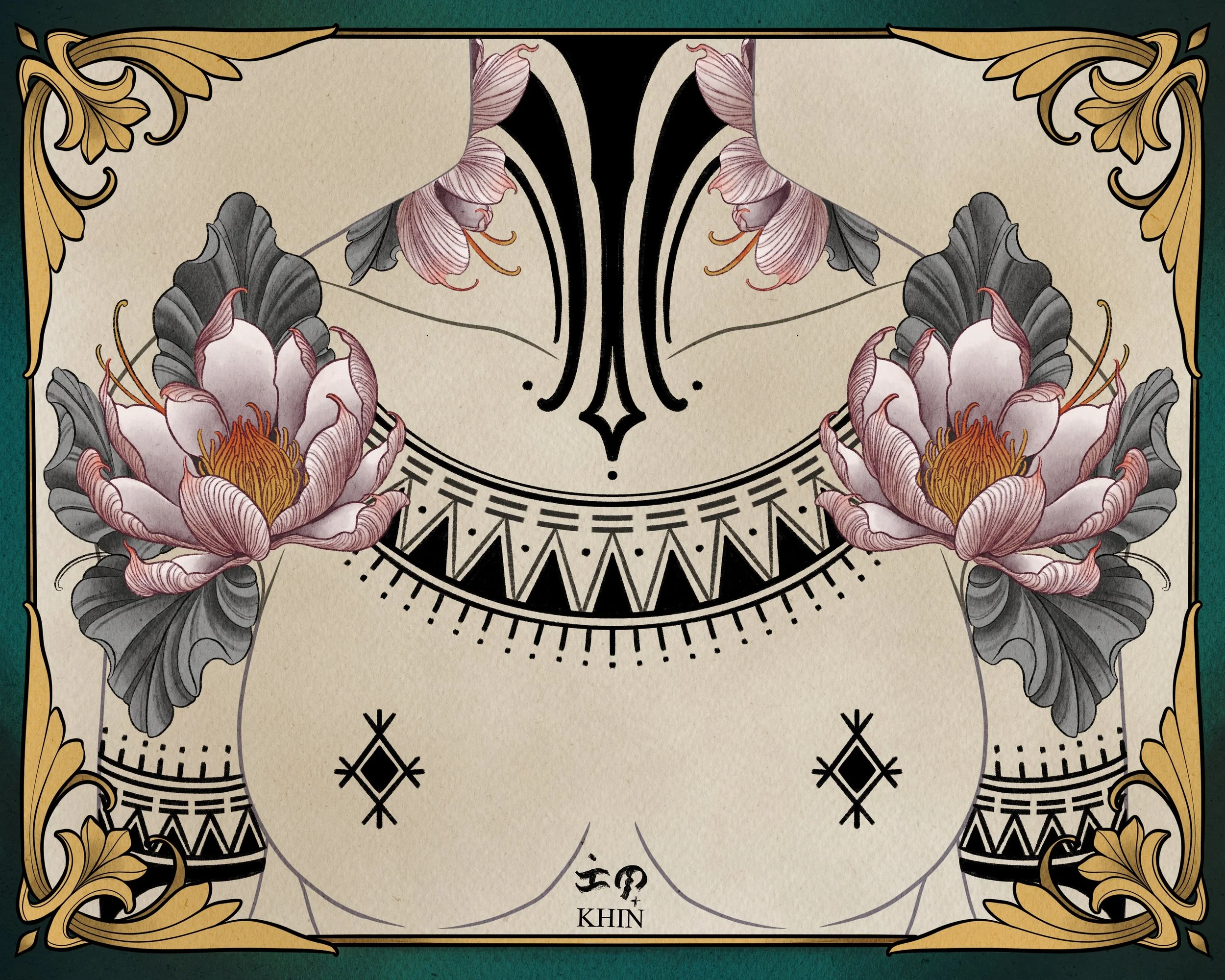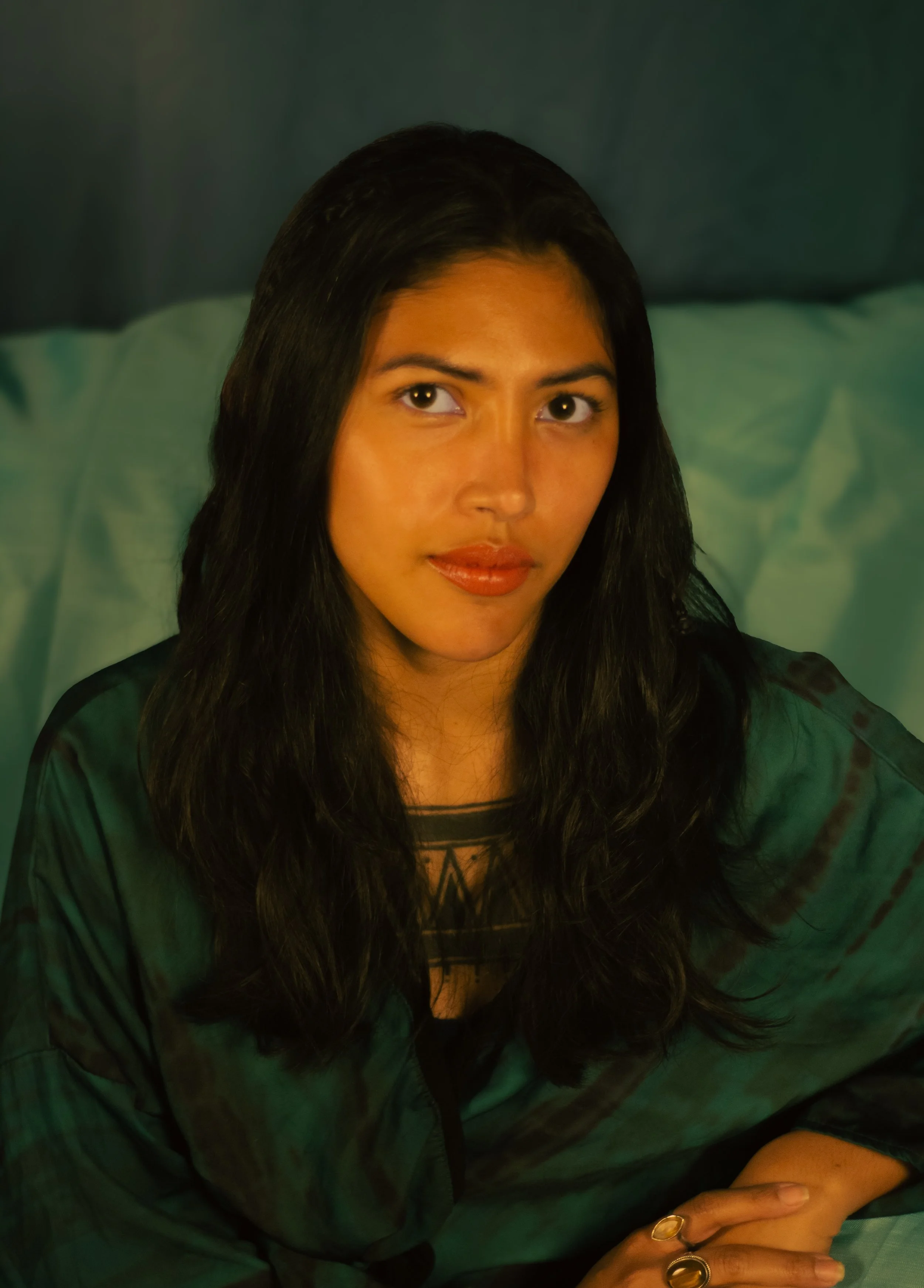
Filipino Mythology and Folklore Art
Carabao
ᜃᜍᜊᜏ᜔
Known for their physical strength and ability to endure long hours of labor. In this sense, they mirror the strength of the Filipino people, especially in the face of hardship and adversity.
The carabao is a powerful symbol of strength, hard work, and resilience.
A loyal companion to farmers, it represents the Filipino spirit, humble, enduring, and deeply connected to the land. 🇵🇭
Mebuyan
ᜋᜒᜊᜓᜌᜈ᜔
The maternal goddess of the afterlife. In the Bagobo Story, a Demi God named Mebuyan tried to ascend to the heavens, her body trembled on her way and got sick. So she went back to earth and went deeper that she ended up where the souls of the dead journey. As Mebuyan went below the earth, her body changed. Her skin shimmered with the color of soil and moonlight, and her entire body sprouted many breasts. This transformation symbolized her eternal role: to nourish the souls of dead infants who died before they could taste life. These babies, lost too soon, would cry endlessly at the gates of the underworld. Mebuyan, hearing their cries, took them into her arms and nursed them with her many breasts, giving them the warmth, love, and sustenance they never received on Earth. Once they were strong enough, she would bathe them in the black river of the underworld, cleansing them of earthly pain before sending their souls to reunite peacefully with their other dead family.
Santelmo /St. Elmo’s fire
ᜐᜈ᜔ᜆᜒᜎ᜔ᜋᜓ
The Santelmo, also known as Saint Elmo’s Fire, is a fascinating cryptid from Filipino folklore. Often appearing as a ball of fire, it is typically seen floating over marshes, graveyards, and desolate areas. This phenomenon has been linked to the eerie glow known as Saint Elmo’s Fire, which sailors observed on ships’ masts during storms. However, in the Philippines, the Santelmo has a more mystical and ominous connotation.
Urduha
ᜂᜇᜓᜑ
A warrior queen of a matriarchal dynasty, Urduha was a 14th century ruler of Tawalisi, in what is now known as Pangasinan. Princess Urduha was trained in the art of war since she was a child, and became an expert in using the kampilan and a skilled navigator. Known far and wide, she was famous for leading a retinue of women warriors who were skilled fighters, equestrians, and experts in weaponry. With bodies of strength and muscular physique, they were known as Kinalakian, or Amazons. The legend of Princess Urduha can be attributed to the story of when she met the greatest traveler in history, Ibn Battuta.
Darna
ᜇᜍ᜔ᜈ
Darna is a deceased extraterrestrial warrior magically manifesting herself through a woman from Earth named Narda who summons her by shouting her name. As Darna, she stands up for those who cannot fend for themselves. She fights against common criminals as well as greater forces of evil, most famously the snake-haired super villain Valentina.
Naga/Oryol
ᜈᜄ ᜵ ᜂᜍ᜔ᜌᜓᜎ᜔
In Filipino mythology, especially in the Visayan islands, she is known as the Naga — the guardian of lakes and sea trenches, protector of nature’s deepest secrets.
They say she sometimes falls in love with humans, and other times, she tests their courage, appearing in dreams or from beneath the still waters when the moon is full.
Tattoo sigil
Pulahan Amulet
ᜀᜈ᜔ᜆᜒᜅ᜔-ᜀᜈ᜔ᜆᜒᜅ᜔
The Babaylan, women of power and wisdom, led rituals for harvest, healing, the hunt, and war. They called upon the supreme sky deity Bathala, along with many other gods, to guide and protect the people.
Tattoos were not mere adornments—they were sigils etched into skin, shields of spirit, and marks of meaning. Each design carried power, a prayer woven into the body.
Two forest dogs beneath the sun. The forest dog, born of these islands, is said to guard the mountains and woods, appearing as omen and protector. The sun shines above as Bathala, the Creator, breathing life into all beings—guide, maker, wayfinder.
Ina: Haligi ng tahanan
ᜁᜈ: ᜑᜎᜒᜄᜒ ᜈᜅ᜔ ᜆᜑᜈᜈ᜔
Our spiritual guides were Babaylan—female shamans, healers, and wisdom keepers. As bearers of life, women were seen as the “ilaw ng tahanan” or light of the home—a guiding flame for the whole community.
Women were associated with light, creation, and divine connection. The Divine Feminine was believed to have a powerful bond with the Creator, the ancestors, and the gods—serving as a bridge between the seen and unseen worlds.
This heritage reminds us of the sacred role women once held—and continue to carry—as vessels of creation and keepers of light.
Pirena Engkantadia
ᜐᜅ᜔ᜍᜒ ᜉᜒᜍᜒᜈ
Sang’gre Pirena of Lireo — firstborn daughter of Diwata, rightful heir in her own heart, and the fierce keeper of the Fire Gem — was destined for greatness from the moment she opened her eyes. As the eldest, she believed the throne was not only her duty but her birthright, a truth etched into her very spirit. But when that destiny was denied to her, something within Pirena cracked. Her pride, sharpened by years of expectation, turned into determination…and then into something darker. With the arrival of Amihan, the gentle second goddess, Pirena’s world shifted. She refused to accept Amihan as her sister, her heart already heavy with the fear of being replaced. Pirena’s nature — cunning, proud, and fiercely vengeful — soon became the whispered fear of the kingdom. And when she overheard the people saying they were afraid of her, the wound cut deep. That hurt became fuel. That fuel became fire. And with that fire burning through her, Pirena vowed to claim the throne no matter the cost. She made it her personal conquest to rise above all, even if it meant standing against her own blood. What followed was a legendary clash between sisters — a battle of destiny, pride, and the unquenchable blaze of a woman who refused to be overshadowed.
A Filipino Fable: The turtle and the monkey. A monkey and a turtle found a banana tree on a river. They fished it out and because each wanted the tree for himself, they cut it in half. Now the monkey, being the stronger one, took the part with leaves despite the turtle’s protests, and carefully planted it in his backyard. The turtle did the same for his part. But because the part the monkey got had no roots, it died, while the turtle’s lived and sprouted leaves. One day, the monkey visited the turtle and they talked about their banana plants. “Alas! My banana tree is dead!” wailed the monkey tearfully. “And yours?” “Alive, and bearing fruit! But because I can’t climb up...” “Don’t worry!” interrupted the monkey. “I’ll climb up for you.” The turtle became very happy and accompanied the monkey to the place where the banana tree was. The monkey climbed the tree at once and started eating, filling both cheeks. “Give me some, too,” begged the turtle. “Krrr! Not even the peels!” answered the monkey. So, to get even with the monkey, the turtle nailed thorns and susông-paitan (a kind of snail with a small and pointed shell as its house) on the trunk of the banana tree, and went to hide under a coconut shell. “Ow! Ow!” said the monkey as he came down from the tree, and with much pain, went to sit on the coconut shell to tend his wounds. But while he was pulling out the thorns and snails, his restless tail went inside a hole in the coconut shell. The turtle, who saw a good opportunity, bit it. The monkey jumped and saw stars from the pain. “So it’s you!” exclaimed the monkey coarsely as he lifted the coconut shell. “Now I will make you pay for everything you did!” You shall die! But how? Ah! Do you want me to crush you in this mortar or throw you into the river?” “Crush me in the mortar but please don’t throw me in the river: I don’t want to drown!” “Aha! So, you’re afraid of drowning? I guess I’ll have to drown you then!” And into the river he threw the turtle who swam away happily. As the saying goes: The monkey may be smart yet he can still be fooled. Translated by Paolo Ven Capulan
Turtle and the Monkey
Pagong at Matsing
ᜉᜄᜓᜅ᜔ ᜀᜆ᜔ ᜋᜆ᜔ᜐᜒᜅ᜔
Wild Water Lily
ᜎᜒᜍ᜔ᜌᜓ
The Manobo tribe, one of the oldest and most prominent indigenous groups in the Philippines, resides in various regions, including Lake Sebu in South Cotabato, a city, rich in culture and beauty. One of the most popular sites of lake Cebu is their Water Lily Garden where locals canoe and enjoy the warm heat of the sun.
Zodiac Symbol
ᜐᜓᜇᜒᜌᜃ᜔ ᜐᜒᜋ᜔ᜊᜓᜎ᜔ᜐ᜔
Filipino Daggers
(SUNDANG)
ᜀᜇ᜔ᜎᜏ᜔ ᜂᜄ᜔ ᜊᜓᜎᜈ᜔
In the Manobo tribe of pre-colonial Philippines, Adlaw (the Sun) and Bulan (the Moon) were a married couple who had a child named Bituon (the Star). One day, the couple got into a terrible quarrel, and Adlaw ended up murdering their child, shredding him into pieces. Enraged and heartbroken, Bulan left her husband and took the pieces of their child with her. This is what the ancestors believed explains why the Moon appears with the stars at night, while the Sun remains alone during the d
-
Khin
Artist
Hi, I'm Khin! I'm a tattoo artist that specializes in Neo-Traditional. Most of my work revolves around images that has stories behind them.

